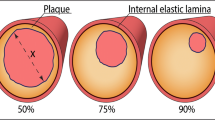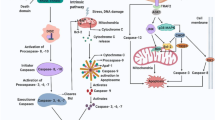Abstract
The expression of heat shock proteins (hsp) increases in case of variable types of endogenous and exogenous cellular stress, as for example thermal stress. Immunohistochemical staining with hsp antibodies can visualize these stress proteins. Fifty-three cases of death due to heat and a control group of 100 deaths without any antemortem thermic stress were examined regarding hsp27 and hsp70 expression in myocardial, pulmonary, and renal tissues. The results revealed a correlation between hsp expression, survival time, and cause of death. In cases of death due to fire, the expression of hsp is more extensive than in the control group, especially in pulmonary and renal tissues. The immunohistochemical investigation of an hsp expression can support the proof of vitality in cases of death related to fire.














Similar content being viewed by others
References
Ritossa F (1962) A new puffing pattern induced by heat shock and DNP in Drosophila. Experimentia 18:571–573
Morimoto RI, Milarski KL (1990) Expression‚ and function of vertebrate hsp70 genes. In: Morimoto RI, Tissières A, Georgopoulos C (eds) Stress proteins in biology and medicine, vol 19, Monograph. Cold Spring Harbor Laboratory Press, Cold Spring Harbor, pp 323–359
Ciocca DR, Oesterreich S, Chamness GC, McGuire WL, Fuqua SAW (1993) Biological and clinical implications of heat shock protein 27000 (Hsp27): a review. J Natl Cancer Inst 85:1558–1570
Agashe VR, Hartl FU (2000) Roles of molecular chaperones in cytoplasmic protein folding. Semin Cell Dev Biol 11:15–25
Hartl FU (1996) Molecular chaperones in cellular protein folding. Nature 381:571–580
Walter S, Buchner J (2002) Molecular chaperones—cellular machines for protein folding. Angew Chem Int Ed Engl 41:1098–1113
Hendrick JP, Hartl FU (1993) Molecular chaperone functions of heat-shock proteins. Annu Rev Biochem 62:349–384
Zylicz M, Wawrzynow A (2001) Insights into the function of Hsp70 chaperones. Life 51:283–287
Welch WJ (1993) Stress-Proteine. Spektrum der Wissenschaft 7:40–47
Feder ME, Hofmann GE (1999) Heat-shock proteins, molecular chaperones, and the stress response: evolutionary and ecological physiology. Annu Rev Physiol 61:243–282
Benndorf R, Bielka H (1997) Cellular stress response: stress proteins—physiology and implications for cancer. Recent Results Cancer Res 143:129–144
Marschall S (2005) Expression von Hitzeschockprotein 70 (Hsp70) in den Atemwegen und Lungen bei Brandtodesfällen. Dissertation Freiburg, pp 51-62
Kowal-Vern A, Goral J, Gamelli RL, McGill V, Clancy J (2000) Hsp70, hsp32, and grp78 are increased in thermally injured skin with and without antithrombin (human) concentrate infusion. J Burn Care Rehabil 21:213–219
Marschall S, Rothschild MA, Bohnert M (2006) Expression of heat-shock protein 70 (Hsp70) in the respiratory tract and lungs of fire victims. Int J Legal Med 6:355–359
Bohnert M, Werner CR, Pollak S (2003) Problems associated with the diagnosis of vitality in burned bodies. Forensic Sci Int 135:197–205
Maxeiner H (1988) Umstände und Befunde bei 202 Brandtodesfällen. Beitr Gerichtl Med 46:313–325
Issels RD, Hegewisch-Becker S (2006) Chemotherapie in Kombination mit Hyperthermie. in: Schmoll HJ, Höffken K, Possinger K (Hrsg.):Kompendium Internistische Onkologie. Standards in Diagnostik und Therapie. 4. Aufl., Springer 17, pp 1090-1108
Becker VT (2004) Einfluss der Temperatur auf die Lungenfunktionsparameter im Rahmen der isolierten hyperthermen Lungenperfusion. Dissertation Jena, p 10
Doberentz E, Genneper L, Madea B (2011) Plötzlicher Säuglingstod. Keine renale Hitzeschockproteinexpression. Z Rechtsmed 21:522–526
Preuss J, Dettmeyer R, Poster S, Lignitz E, Madea M (2008) The expression of heat shock protein 70 in kidneys in cases of death due to hyperthermia. Forensic Sci Int 176:248–252
Bohnert M, Anderson J, Rothschild MA, Böhm J (2010) Immunohistochemical expression of fibronectin in the lungs of fire victims proves intravital reaction in fatal burns. Int J Legal Med 124:583–588
Amrani M, Latif N, Morrison K, Gray CC, Jayakumar J, Corbett J, Goodwin AT, Dunn MJ, Yacoub MH (1998) Relative induction of heat shock protein in coronary endothelial cells and cardiomyocytes: implications for myocardial protection. J Thorac Cardiovasc Surg 115:200–209
Leger JP, Smith FM, Currie RW (2000) Confocal microscopic localisation of constitutive and heat shock-induced proteins HSP70 and HSP27 in the rat heart. Circulation 102:1703–1709
Currie RW, Ellison JA, White RF, Feuerstein GZ, Wang X, Barone FC (2000) Benign focal ischemic preconditioning induces neuronal hsp70 and prolonged astrogliosis with expression of hsp27. Brain Res 863:169–181
Landry J, Chretien P, Laszlo A, Lambert H (1991) Phosphorylation of HSP27 during development and decay of thermotolerance in Chinese hamster cells. J Cell Physiol 147:93–101
Beissinger M, Buchner J (1998) How chaperones fold proteins. Biol Chem 379:245–259
Rahim RA, Boyd PA, Ainslie Patrick WJ, Burdon RH (1996) Human heat shock protein gene polymorphisms and sudden infant death syndrome. Arch Dis Child 75:451–452
Author information
Authors and Affiliations
Corresponding author
Additional information
Doberentz E. and Genneper L. are both first authors.
Rights and permissions
About this article
Cite this article
Doberentz, E., Genneper, L., Böker, D. et al. Expression of heat shock proteins (hsp) 27 and 70 in various organ systems in cases of death due to fire. Int J Legal Med 128, 967–978 (2014). https://doi.org/10.1007/s00414-014-0994-0
Received:
Accepted:
Published:
Issue Date:
DOI: https://doi.org/10.1007/s00414-014-0994-0




